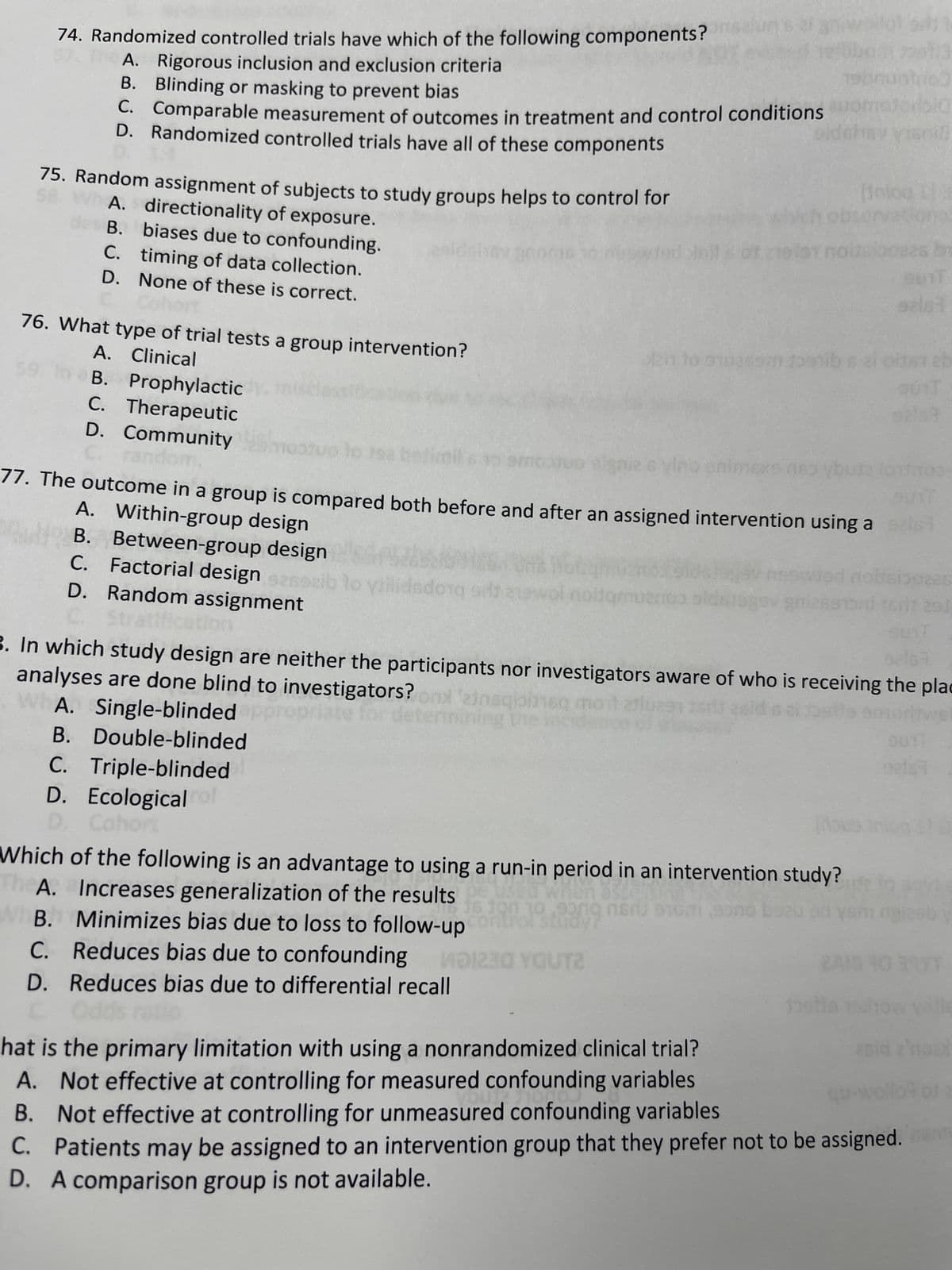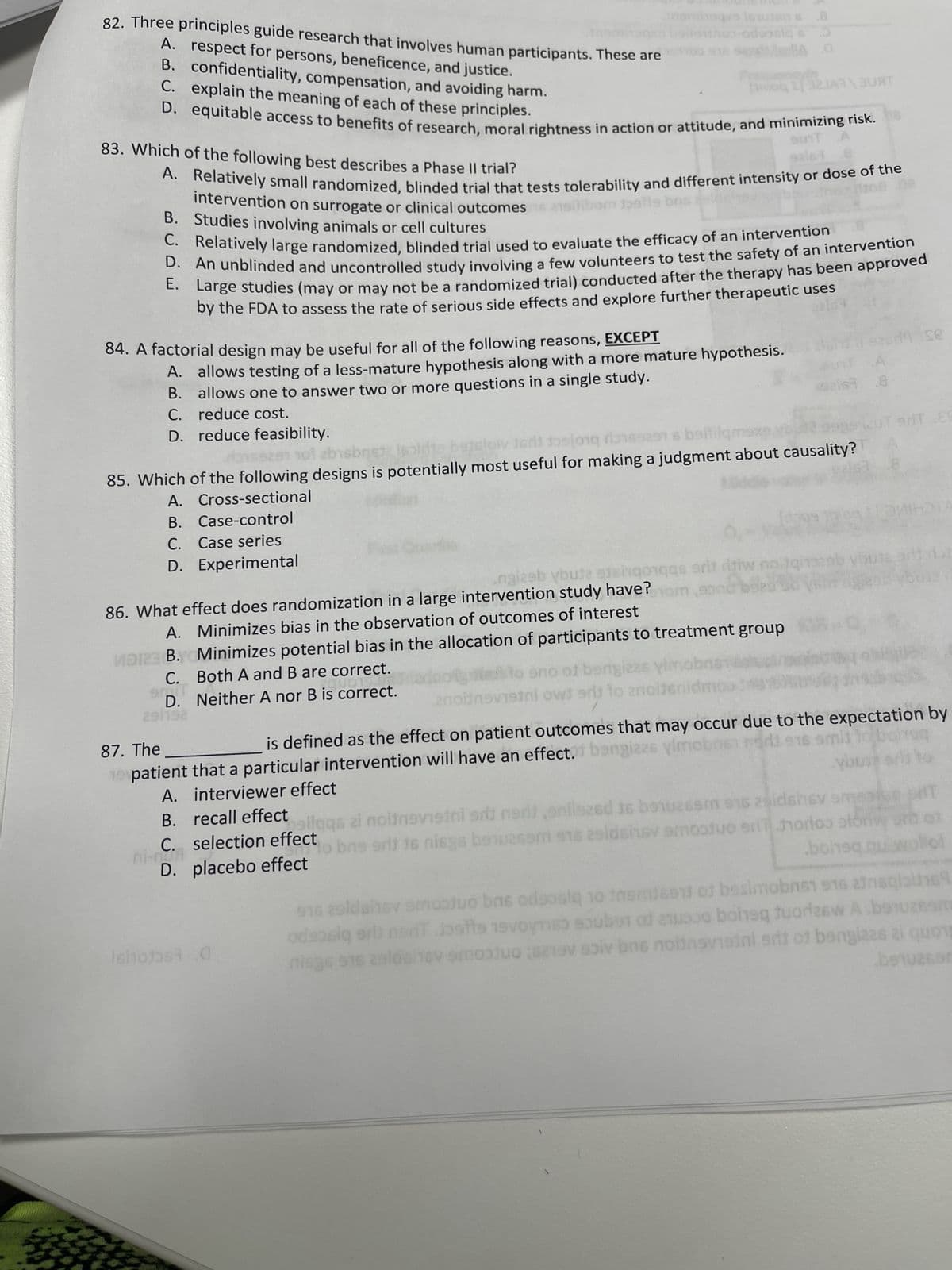Randomized controlled trials have which of the following components? A. Rigorous inclusion and exclusion criteria B. Blinding or masking to prevent bias C. Comparable measurement of outcomes in treatment and control conditions o D. Randomized controlled trials have all of these components
Randomized controlled trials have which of the following components? A. Rigorous inclusion and exclusion criteria B. Blinding or masking to prevent bias C. Comparable measurement of outcomes in treatment and control conditions o D. Randomized controlled trials have all of these components
MATLAB: An Introduction with Applications
6th Edition
ISBN:9781119256830
Author:Amos Gilat
Publisher:Amos Gilat
Chapter1: Starting With Matlab
Section: Chapter Questions
Problem 1P
Related questions
Question
Answer this following questions?

Transcribed Image Text:75. Random assignment of subjects to study groups helps to control for
A. directionality of exposure.
B.
74. Randomized controlled trials have which of the following components?
A. Rigorous inclusion and exclusion criteria
B. Blinding or masking to prevent bias
C. Comparable measurement of outcomes in treatment and control conditions
D. Randomized controlled trials have all of these components
76. What type of trial tests a group intervention?
A. Clinical
C.
D.
A.
B.
C.
D.
B.
A.
B.
biases due to confounding.
timing of data collection.
None of these is correct.
B. Prophylactic
C. Therapeutic
D. Community estuoto
random.
B.
C.
D.
Between-group design
Factorial design sasszib to yiilidsdong sta
Random assignment
Str
C.
D. Ecological rol
D. Cohort
toms
2h to stuees toob
nimexe
BUTT
A. Within-group design
77. The outcome in a group is compared both before and after an assigned intervention using a dist
Pad
..
Which of the following is an advantage to using a run-in period in an intervention study?
Increases generalization of the results used when Stdessin
16 100 10,900g nor 910m sono boeu
Minimizes bias due to loss to follow-up control study?
Reduces bias due to confounding MD1230 YOUT2
Reduces bias due to differential recall
Odds
noidqmuenos sidslags
[dous
onuotno
92167
3. In which study design are neither the participants nor investigators aware of who is receiving the plac
analyses are done blind to investigators? on 'einaqibineq moit aftluas
WA. Single-blinded OP
riate
Double-blinded
Triple-blinded
135
snif
Inlog E
as be
BUIT
aziat
01512b
That is the primary limitation with using a nonrandomized clinical trial?
Not effective at controlling for measured confounding variables
OUT TO
Not effective at controlling for unmeasured confounding variables
C.
Patients may be assigned to an intervention group that they prefer not to be assigned.
D. A comparison group is not available.
92167
hos
291
bol

Transcribed Image Text:82. Three principles guide research that involves human participants. These are
A. respect for persons, beneficence, and justice.
\ II 321A330RT
B. confidentiality, compensation, and avoiding harm.
C. explain the meaning of each of these principles.
D. equitable access to benefits of research, moral rightness in action or attitude, and minimizing risk.
SUIT A
istens 8
83. Which of the following best describes
a Phase II trial?
A. Relatively small randomized, blinded trial that tests tolerability and different intensity or dose of the
del
B.
intervention on surrogate or clinical outcomes asilibom balls bris
Studies involving animals or cell cultures
C. Relatively large randomized, blinded
trial used to evaluate the efficacy of an intervention
D. An unblinded and uncontrolled study involving a few volunteers to test the safety of an intervention
E. Large studies (may or may not be a randomized trial) conducted after the therapy has been approved
by the FDA to assess the rate of serious side effects and explore further therapeutic uses
inoo-odsosiq s
84. A factorial design may be useful for all of the following reasons, EXCEPT
A. allows testing of a less-mature hypothesis along with a more mature hypothesis.
B. allows one to answer two or more questions in a single study.
C. reduce cost.
D. reduce feasibility.
A.
MD23 B.
0769291 101 eb
85. Which of the following designs is potentially most useful for making a judgment about causality?
A.
52163
Cross-sectional
Case-control
B.
C. Case series
D. Experimental
qs srit ritiw
86. What effect does randomization in a large intervention study have?hom aond
Minimizes bias in the observation of outcomes of interest
Minimizes potential bias in the allocation of participants to treatment group
Both A and B are correct.
a) to eno of bengieas yim
tadoot
Neither A nor B is correct.
enoitnsvistni owt add to anoiten
C.
90 T
D.
29/192
Ishots .0
.A
163 8
99
qis29b
se
arT.ES
87. The
is defined as the effect on patient outcomes that may occur due to the expectation by
patient that a particular intervention will have an effect. bengizzs vimobos nord ens smil to bottoq
19
A.
interviewer effect
B.
silgqs zi noitnevetni sdi neri nilazed to benuzsam 915 29idshev smepice T
recall effect
to bns erit 16 nisgs benuasom 916 zaldsinsv amooduo sri hortoo stori
C. selection effect
ni-04-
D. placebo effect
bohsq qu-wollet
916 20ldshev smootuo bas odsosiq 10 ihmiset of besimobris 916 atnaqlaine
odsosią srit nor Jostte 19voymes souber of so boisq fuarlesw A bonuzeom
niegs 916 29lási16 mot soiv bns nolingvisini srit of banglaes ei quons
benuacon
v
Expert Solution
This question has been solved!
Explore an expertly crafted, step-by-step solution for a thorough understanding of key concepts.
Step by step
Solved in 2 steps

Recommended textbooks for you

MATLAB: An Introduction with Applications
Statistics
ISBN:
9781119256830
Author:
Amos Gilat
Publisher:
John Wiley & Sons Inc

Probability and Statistics for Engineering and th…
Statistics
ISBN:
9781305251809
Author:
Jay L. Devore
Publisher:
Cengage Learning

Statistics for The Behavioral Sciences (MindTap C…
Statistics
ISBN:
9781305504912
Author:
Frederick J Gravetter, Larry B. Wallnau
Publisher:
Cengage Learning

MATLAB: An Introduction with Applications
Statistics
ISBN:
9781119256830
Author:
Amos Gilat
Publisher:
John Wiley & Sons Inc

Probability and Statistics for Engineering and th…
Statistics
ISBN:
9781305251809
Author:
Jay L. Devore
Publisher:
Cengage Learning

Statistics for The Behavioral Sciences (MindTap C…
Statistics
ISBN:
9781305504912
Author:
Frederick J Gravetter, Larry B. Wallnau
Publisher:
Cengage Learning

Elementary Statistics: Picturing the World (7th E…
Statistics
ISBN:
9780134683416
Author:
Ron Larson, Betsy Farber
Publisher:
PEARSON

The Basic Practice of Statistics
Statistics
ISBN:
9781319042578
Author:
David S. Moore, William I. Notz, Michael A. Fligner
Publisher:
W. H. Freeman

Introduction to the Practice of Statistics
Statistics
ISBN:
9781319013387
Author:
David S. Moore, George P. McCabe, Bruce A. Craig
Publisher:
W. H. Freeman